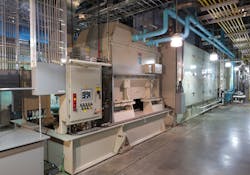This week two years ago, Superstorm Sandy put the ‘city that never sleeps at night’ into a near coma, disrupting electric power in some parts of New York for two weeks. It was a painful lesson about the vulnerability of our electric grid, not just in New York, but throughout the Northeast. And it was a wake-up call for government leaders about the value of microgrids.
So it is fitting that today we are releasing the second report in our Think Microgrid series: “The Energy Efficient Microgrid: What Combined Heat & Power and District Energy Bring to the Microgrid Revolution.” The report is simultaneously being announced by the International District Energy Association at its evolvingENERGY conference in Toronto.
You can download the free report here. Or read the report’s introduction below.
A kind of collective ‘ah ha’ is driving North America toward a more distributed grid, what some call local energy. Businesses, industrial facilities, institutions and cities are realizing the value of taking control over their energy supply.
Local energy promises lower costs, more reliable electric supply, storm resiliency, reduced pollution, greater efficiency, community economic development and jobs, and less forfeiture of open space, habitat and aesthetics to big power plants and transmission lines. Local energy gives communities and businesses the ability to determine their energy future, rather than rely on large, distant corporations, sometimes operated by companies in other states or even countries.
Microgrids are central to this move toward local energy in the United States and Canada. Although they’ve been around for a century, microgrids are particularly attractive in their contemporary form because they bring updated technology and extraordinary intelligence to energy management.
These mini versions of the larger grid also are highly energy efficient, particularly when they employ a form of distributed energy known as combined heat and power (CHP).
This guide, our second in the Think Microgrid series, paints a picture of the emerging microgrid-driven world, with CHP at its core.
What exactly is CHP? If you’re not familiar with it – or only vaguely aware – you’re not alone. Its reputation remains under the radar screen, especially compared with solar and wind energy. Yet CHP is a far more proven form of distributed energy that goes back to Thomas Edison’s day and can be found in cities and at hospitals, colleges, hotels, petrochemical facilities, manufacturing companies and many other sites where large amounts of energy are consumed. For a long time CHP seemed like the best-kept-secret of energy insiders. That’s begun to change as government leaders push for more CHP – from mayors to the highest offices. In fact, President Barack Obama has set a goal for the U.S. to add 40 GW of CHP by 2020.
Cornell University Central Energy Plant. Courtesy of Solar Turbines
Also called cogeneration, it is often extolled for its two-for-one advantage. CHP derives twice as much energy from the same amount of fuel as does a conventional power plant. Think of it this way. Spend one dollar on fuel to operate a conventional power plant and you derive a certain amount of electricity. Spend one dollar of fuel to operate a CHP plant and you derive the same amount of electricity, plus heat energy that you can use to heat or cool buildings, manufacture products, or use in some other heat-intensive process.
In addition to CHP, this guide focuses on a closely allied technology, district energy (DE). These systems, too, are big part of the emerging microgrid story. District energy offers tremendous energy and environmental advantage. In brief, a district energy system supplies steam or hot water for space heating and chilled water for air conditioning through an underground piping network, enabling connected customer buildings to avoid installation of boilers, chillers and cooling towers. The thermal grid creates an economy of scale that facilitates deployment of CHP and other highly efficient or renewable technologies.
District energy often incorporates CHP. And when microgrid capabilities are added to CHP/DE systems, they operate with a new level of sophistication, one that offers cost savings and revenue potential.
Microgrids, CHP and district energy share a common slice of the energy market – one that creates a new value proposition for the energy consumer. Their slice of the energy world is very much about energy efficiency and enhanced reliability – and it’s a slice that’s getting bigger and more important.
MicrogridKnowledge.com prepared this guide to:
- Show large energy users the benefits that CHP and district energy microgrids offer
- Inform policymakers and regulators about how CHP/DE microgrids can help them achieve important energy, economic and environmental goals
- Offer insight into polices needed to foster these energy systems
- Heighten awareness within the CHP and district energy industries about the new opportunity created for them by the rapid adoption of microgrids
For those considering installing a microgrid, we offer recommendations on what you need to consider. We profile successful microgrids, CHP and district energy systems. And last, we offer a comprehensive list of CHP incentives and policies, which was provided courtesy of the US Environmental Protection Agency’s CHP Partnership.
The Energy Efficient Microgrid: What Combined Heat & Power and District Energy Bring to the Microgrid Revolution is provided as a free download, courtesy of Solar Turbines and the International District Energy Association.
Please note: This guide explores grid-connected CHP/DE microgrids. We do not focus on remote microgrids or those that use solar or wind as their primary fuels. However, MicrogridKnowledge.com plans to publish future Think Microgrid guides that cover these systems and the distinct advantages they offer. For more information contact [email protected].







